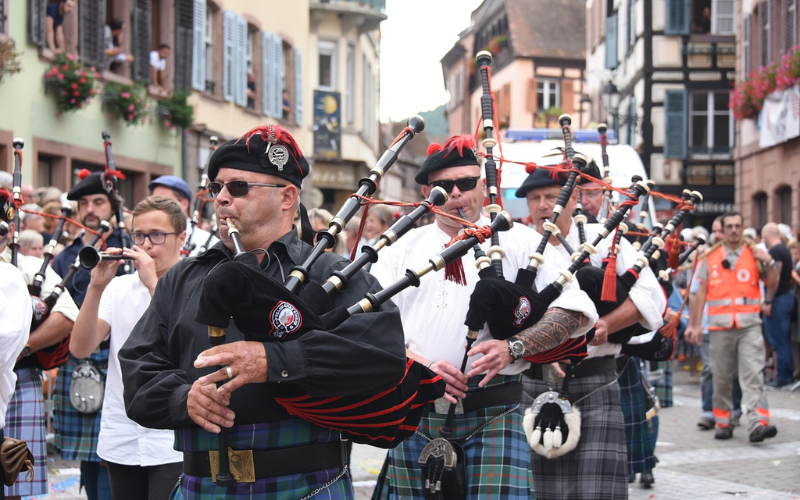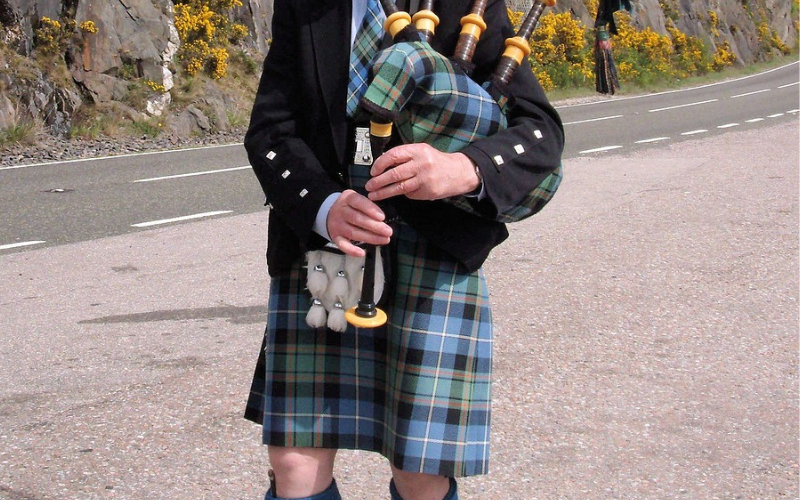In the rich tapestry of cultural traditions, the Piper’s Kilt stands out as a symbol of both heritage and fashion. This article delves into the melodic journey of this iconic attire, exploring its historical roots, symbolic significance, evolution of style, and its influence on modern fashion trends.

Historical Roots of the Piper's Kilt
Originating as practical attire suited for the challenging terrains of these regions, the kilt initially served a utilitarian purpose, offering freedom of movement for those navigating the rugged landscapes. As centuries passed, the kilt transformed beyond its functional role and became a powerful symbol of cultural identity.
Distinct tartan patterns emerged, each representing a specific clan or community, fostering a sense of belonging and shared heritage. The Piper’s Kilt, therefore, carries within its fabric the echoes of centuries-old traditions, encapsulating the resilience and pride of Celtic communities.
This historical depth lends a unique and profound significance to the Piper’s Kilt, making it more than just a piece of clothing—it is a living testament to the enduring spirit of a rich cultural legacy.
Symbolism Behind the Piper's Kilt
Beyond its aesthetic appeal, the Piper’s Kilt is laden with symbolism. Each element, from the tartan patterns to the accessories, carries a specific meaning. Unraveling these symbolic layers adds depth to the understanding of the attire.
Evolution of Style in Piping
The evolution of style in piping, particularly concerning the Piper’s Kilt, showcases a fascinating journey through different eras and fashion trends. Initially rooted in traditional Celtic attire, the Piper’s Kilt has undergone significant transformations over time. Changes in materials, colors, and design elements have marked distinct periods, reflecting the adaptability of this iconic garment.
Historically, the kilt was a practical garment for outdoor activities, characterized by earthy tones and sturdy fabrics. As fashion norms evolved, so did the Piper’s Kilt, incorporating diverse influences while maintaining its core identity. In more recent times, there has been a revival of interest in traditional styles, leading to a resurgence of classic designs.
Contemporary designers often draw inspiration from the rich history of the Piper’s Kilt, infusing modern elements without compromising its authenticity. The evolution of style in piping is a testament to the garment’s timeless appeal, bridging the gap between tradition and contemporary fashion. This ongoing metamorphosis ensures that the Piper’s Kilt remains not only a symbol of cultural heritage but also a dynamic and relevant expression of style in the ever-changing landscape of fashion.
Influence on Modern Fashion
The allure of the Piper’s Kilt extends beyond traditional settings. Modern fashion designers draw inspiration from its classic elements. The section examines how the Piper’s Kilt has influenced and shaped contemporary fashion, making it a timeless style statement.
Craftsmanship of the Piper's Kilt
The craftsmanship of the Piper’s Kilt is a testament to the intricate artistry that goes into creating this iconic garment. Skilled artisans meticulously weave a tapestry of tradition, employing time-honored techniques that have been passed down through generations.
The process begins with the selection of high-quality materials, often including pure wool for the kilt itself. Artisans then painstakingly hand-weave the fabric, paying meticulous attention to the specific tartan pattern associated with the wearer’s clan or region. This intricate weaving process is not only a skillful craft but a labor of love that imbues each Piper’s Kilt with a unique identity.
The construction of the kilt involves precision in pleating and folding, ensuring that the garment drapes elegantly while maintaining its distinctive appearance. Accessories like sporrans and belts, crafted with attention to detail, complement the overall ensemble.
Beyond the technical aspects, the craftsmanship of the Piper’s Kilt is an art form that embodies cultural pride and heritage. Each kilt becomes a canvas, telling a story through its patterns and colors, and the hands that meticulously bring it to life contribute to the preservation of a rich cultural tradition. The Piper’s Kilt, therefore, stands not just as a garment but as a masterpiece, a living testament to the dedication of skilled artisans who continue to breathe life into this enduring symbol of tradition and style.
Variations Across Regions
The Piper’s Kilt isn’t a one-size-fits-all attire. Different regions have their unique variations, reflecting the diverse cultural landscapes. From Scottish kilts to Irish variations, this section showcases the regional nuances in Piper’s Kilt styles.
Notable Figures and Their Kilts
Throughout history, influential figures have embraced the Piper’s Kilt. This section profiles individuals who have left a lasting impact on the legacy of the attire, celebrating their contributions to its cultural significance.
Musical Harmony and the Piper's Kilt
The union of musical harmony and the Piper’s Kilt creates a captivating synergy, enhancing the cultural and artistic experience. Musicians don the Piper’s Kilt during performances, establishing a visual connection between the attire and the melodic rhythms of traditional music. The kilt, with its distinctive patterns and colors, becomes an integral part of the musical narrative.
Beyond its aesthetic appeal, the Piper’s Kilt holds a symbolic resonance in the world of music. It signifies a deep connection to cultural roots and traditions, enriching the auditory experience for both performers and audiences. The sway of the kilt in tandem with the music adds a dynamic visual element, enhancing the overall impact of the performance.
In addition to traditional music, the Piper’s Kilt has also found a place in various genres, contributing to a cross-cultural fusion of styles. The harmonious blend of the kilt’s visual symbolism with diverse musical genres underscores its versatility and enduring relevance in the contemporary music scene.
Ultimately, the Piper’s Kilt serves as more than just a garment; it becomes a visual instrument, harmonizing with the melodies and rhythms, creating a sensory experience that transcends the boundaries between sight and sound.

Cultural Celebrations and the Piper's Kilt
Participation in cultural festivals and events is a common sight for those donning the Piper’s Kilt. This section highlights the role of the attire in various celebrations, showcasing its vibrant presence in cultural gatherings.
Popularity in Pop Culture
The Piper’s Kilt has transcended its traditional roots to achieve remarkable popularity in pop culture, leaving an indelible mark across various forms of entertainment. This iconic attire, with its distinct tartan patterns and cultural significance, has become a recognizable symbol in movies, music, and literature.
In cinema, the Piper’s Kilt often appears as a powerful visual cue, representing heritage, tradition, and a touch of exoticism. Filmmakers incorporate the kilt to evoke a sense of authenticity in historical dramas or to add a unique flair to characters in contemporary settings.
Similarly, the kilt’s influence extends to the music industry, where artists use it as a fashion statement or a nod to their Celtic roots. From album covers to stage costumes, the Piper’s Kilt infuses a touch of cultural richness into the music scene, contributing to its widespread appeal.
Literature, too, embraces the Piper’s Kilt as a symbol of character identity or a plot device. Authors incorporate the garment to convey a sense of tradition or to explore themes of cultural heritage and pride.
The Piper’s Kilt, with its unmistakable charm, has become more than a traditional garment—it’s a cultural icon that seamlessly weaves itself into the tapestry of popular culture, resonating with audiences worldwide.
Challenges in Preserving Tradition
In the face of modernization, preserving the authenticity of the Piper’s Kilt presents challenges. This section addresses the hurdles in maintaining tradition amidst a rapidly changing world.
Revival Efforts and Initiatives
Despite challenges, various initiatives are underway to revive and promote the Piper’s Kilt. This section sheds light on organizations and individuals dedicated to preserving and passing on this cultural legacy.
Tips on Wearing the Piper's Kilt
For those considering embracing the tradition, practical advice on wearing the Piper’s Kilt is essential. This section offers tips and insights to ensure a comfortable and respectful experience.
Conclusion
In conclusion, the Piper’s Kilt remains a captivating symbol of tradition and style. Its journey through history, the symbolism it carries, and its enduring influence on fashion and culture make it a timeless expression of cultural heritage.
FAQs
1. Can anyone wear a Piper's Kilt, or is it reserved for specific occasions?
The Piper’s Kilt is a versatile attire suitable for various occasions. While traditionally associated with certain events, its adaptability allows for broader use.
2. Are there specific rules for wearing the Piper's Kilt?
While there are general guidelines, wearing the Piper’s Kilt often comes down to personal preference. Comfort and respect for tradition are key considerations.
3. How can one distinguish between different regional variations of the Piper's Kilt?
Regional variations often include distinct tartan patterns and accessories. Researching specific cultural details can help in identifying these nuances.
4. Is the Piper's Kilt only popular in Celtic regions, or has it gained global recognition?
While rooted in Celtic traditions, the Piper’s Kilt has gained global popularity, influencing fashion and culture worldwide.
5. Where can one purchase an authentic Piper's Kilt?
Authentic Piper’s Kilts can be purchased from reputable stores specializing in traditional attire. It’s advisable to research and choose a reliable source for authenticity.




Leave a reply